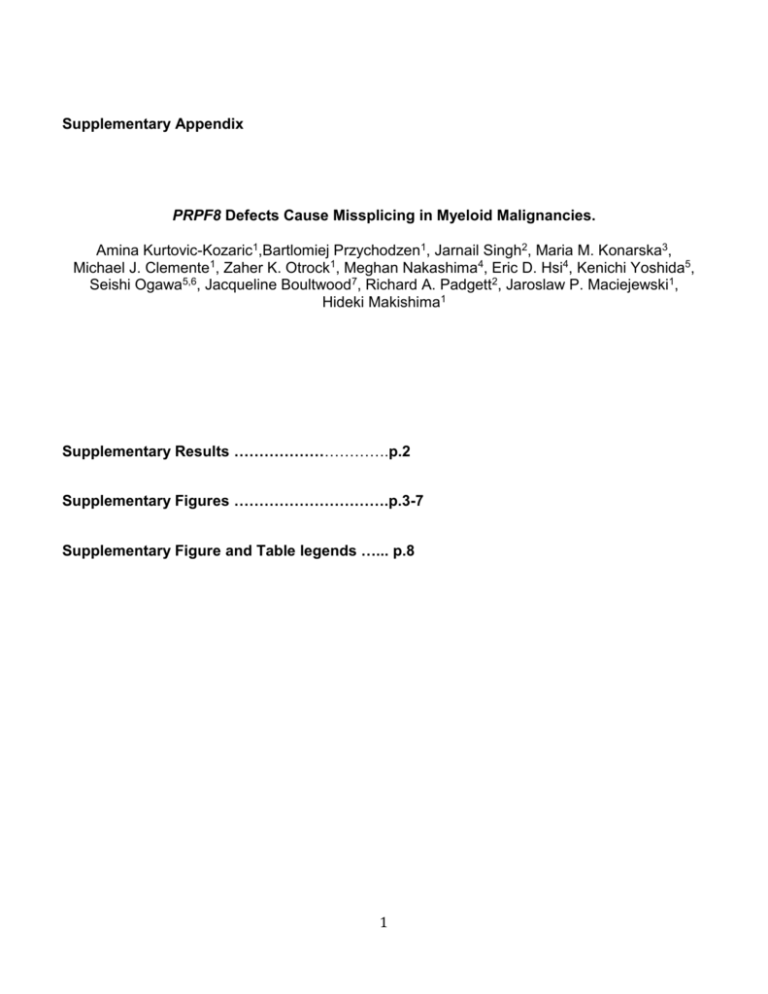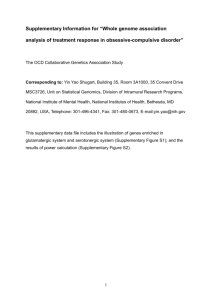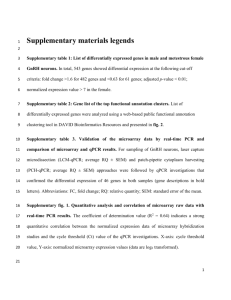Supplementary Figures (doc 658K)
advertisement

Supplementary Appendix PRPF8 Defects Cause Missplicing in Myeloid Malignancies. Amina Kurtovic-Kozaric1,Bartlomiej Przychodzen1, Jarnail Singh2, Maria M. Konarska3, Michael J. Clemente1, Zaher K. Otrock1, Meghan Nakashima4, Eric D. Hsi4, Kenichi Yoshida5, Seishi Ogawa5,6, Jacqueline Boultwood7, Richard A. Padgett2, Jaroslaw P. Maciejewski1, Hideki Makishima1 Supplementary Results ………………………….p.2 Supplementary Figures ………………………….p.3-7 Supplementary Figure and Table legends …... p.8 1 Supplementary Results The gene expression changes associated with RS phenotype To understand the gene expression changes associated with the RS phenotype, we first analyzed the RNA expression patterns of 200 MDS patients grouped by RS phenotype as well as healthy donor samples. We tested 54,671 probes in 21,256 genes. When RS-associated genes were selected based on differential expression (p<.01), over 30% of them were found to be linked to mitochondrial function. Similarly, when we analyzed the 35 samples for which PRPF8 mutational status was available (11 cases of deletion 17p, 12 cases of low PRPF8 expression and 2 cases with PRPF8mutation) by expression array, 20% of the 200 most differentially expressed genes were associated with mitochondrial function. In addition, when we analyzed the overlap between differentially expressed genes in RS cases with and without PRPF8 mutations, several genes involved in the electron transport chain complex were found (Supplementary Figure 3). We also compared the expression pattern of SF3B1 mutant cases to those with defective PRPF8 (Supplementary Figure 3). Remarkably, 3 differentially expressed genes in Complex I of the electron transport chain are shared between SF3B1/PRPF8 mutants and the haploinsufficient del(17p) group. 2 Supplemental Figure 1 3 4 5 6 7 Supplementary Figure 4. 8 Supplementary Figure legends Supplementary Figure 1. PRPF8 mutations and ring sideroblast association. (A) TCGA patient cohort (N=197) was analyzed for PRPF8 expression (low expression (LE),haploinsufficient (del(17p)) and mutant cases are shown separately). (B) 20% of screened patients had spliceosomal mutations. Proportions of individual mutations are shown in the inserted pie chart. (C) Ring sideroblast count in patients from our cohort in either PRPF8 mutant (left) or deletion cases (right). RS cases are shown in brown. Supplementary Figure 2. PRPF8 mutant samples with serial chronological sampling. Two serial cases (A and B) of PRPF8 mutation from diagnosis to disease progression. Each sample, in both patients, shows the presence of thePRPF8 mutation from initial diagnosis. Supplementary Figure 3. Gene expression analysis of patients with PRPF8 mutations. Schematic overlap of the three differentially expressed sets: RARS specific genes, PRPF8 mutation/deletion genes and SF3B1 mutation/low expression genes. The overlap is mostly in mitochondrial genes. Pie charts adjacent to the Venn diagram show classes of genes affected in each case based on their function. Supplementary Figure 4. Knockdown of PRPF8 expression by shRNA.Two lentiviral shRNA constructs were used for RNA knockdown. PRPF8 expression was determined using qRT-PCR for the mRNA. The knockdown achieved was 33% (#329) and and 42% (#330). Control was an empty vector (no shRNA insert; Control SHC001 TRC1.5 Vector: pLKO.1-puro Vector). Supplementary Table 1. List of mutations screened by target deep sequencing. Each amplicon sequenced is given in a row. Name of the target is in Column 1, Chromosome is in Column 2, StartCoordinate in Column 3, StopCoordinate in Column 4, and Length in Column 5. Supplementary Table 2. Basic cohort characteristics of deletion cases including age, gender, IPSS score, and WHO classification. Supplementary Table 3. Clinical data, blood and bone marrow parameters, cytogenetics and survival, on patients with PRPF8 mutation and deletion. Supplementary Table 4. RNA sequencing analyses of TCGA samples based on PRPF8 mutation and deletion casesusing SpliceTrap program.In the first column is the output of SpliceTrap program (LP), in column two is chromosome location, in column 3 is gene name, in columns 4 and 5 are exon 1 boundaries, in columns 6 and 7 are exon2 boundaries, in column 8 and 9 are exon 3 boundaries. Calculations for skipping ratio (WT-mutant) are given in column 10, and values for WT skipping and mutant average in columns 11 and 12. 9






